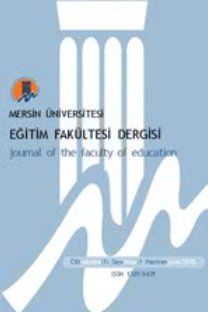A Review of Multimedia Learning Principles: Split-Attention, Modality, and Redundancy Effects
Multimedya ile Öğrenme İlkelerinin İncelenmesi: Biçem, Aşırılık, Dikkat Bölünmesi Etkileri
___
- Chandler, P., & Sweller, J. (1991). Cognitive load theory and the format of instruction. Cognition and Instruction 8(4), 293-332.
- Chandler, P., & Sweller, J. (1992). The split attention effect as a factor in the design of instruction. British Journal of Educational Psychology, 62, 233-246
- Craig, S. D., Gholson, B., & Driscoll, D. M. (2002). Animated pedagogical agents in multimedia educational environments: Effects of agent properties, picture features, and redundancy. Journal of Educational Psychology, 94, 428-434.
- Cuban, L. (1986). Teachers and machines: The classroom use of technology since 1920. New York: Teachers College Press.
- DeLeeuw, K. E., & Mayer, R. E. (2008). A comparison of three measures of cognitive load: Evidence for separable measures of intrinsic, extraneous, and germane load. Journal of Educational Psychology, 100, (1), 223234.
- Erhel,S., & Jamet, E. (2006). Using pop-up windows to improve multimedia learning. Journal of Computer Assisted Learning, 22, 137-147.
- Garner, S. (2002). Reducing the Cognitive Load on Novice Programmers. In P. Barker & S. Rebelsky (Eds.), Proceedings of World Conference on Educational Multimedia, Hypermedia and Telecommunications 2002 (pp. 578-583). Chesapeake, VA: AACE. Retrieved from http://www.editlib.org/p/10329.
- Hooper & Reinartz (2002). Educational Multimedia. In R. A. Reiser, & J. V. Dempsey, (Eds.), Trends and issues in instructional design and technology (pp. 307-318). Upper Saddle River, NJ: Pearson Education, Inc.
- Kalyuga, S., Chandler, P., & Sweller, J. (1998). Levels of expertise and instructional design. Human Factors, 40, 1-17.
- Kalyuga, S., Chandler, P., & Sweller, J. (1999). Managing split-attention and redundancy in multimedia instruction. Applied Cognitive Psychology. 13(1): 351-371
- Liu, T., Lin, Y., Tsai, M. & Paas, F. (2012) Split-attention and redundancy effects on mobile learning in physical environment. Computer & Education 58 (1) 172-180.
- Mayer, R. E. (1997). Multimedia Learning: Are we asking the right question? Educational Psychologist 13, 1-19. Mayer, R. E. (2001). Multimedia learning. Cambridge, England: Cambridge University Press.
- Mayer, R. E. (2005). Introduction to multimedia learning. In R. E. Mayer (Ed.). Cambridge handbook of multimedia learning (pp. 201212). New York: Cambridge University Press.
- Mayer, R. E., & Johnson C. I., (2008) Revising the redundancy principle in multimedia learning. Journal of Educational Psychology, 100, (2), 380386.
- Mayer, R. E., & Moreno, R. (1998). A cognitive theory of multimedia learning: Implications for design principles. In N.H. Naryanan (Ed). Electronic proceedings of the CHI'98 workshop on hyped-media to hyper-media: Toward theoretical foundations of design, use and evaluation. Retrieved on 25th June, 2008 from www.eng.auburn.edu/~narayan/webdocs.html
- Mayer, R. E., Heiser, J., & Lonn, S. (2001). Cognitive constraints on multimedia learning: When presenting more material results in less understanding. Journal of Educational Psychology, 93, 187- 198.
- Miller, G. A. (1956). The magical number seven, plus or minus two: Some limits on our capacity for processing information. Psychological Review, 63, 81-97.
- Moreno, R. & Mayer, R. E. (1999b), Cognitive principles of multimedia design: The role of modality and contiguity, Journal of Educational Psychology, 91, 358368.
- Mousavi, S. Y., Low, R., & Sweller, J. (1995). Reducing cognitive load by mixing auditory and visual presentation modes. Journal of Educational Psychology, 87, 319-334.
- Owens, P., & Sweller, J. (2008). Cognitive Load theory and music instruction. Educational Psychology, 28 (1), 29-45.
- Plass, J. L., Chun, D. M., Mayer, R. E., & Leutner, D. (2003). Cognitive load in reading a foreign language text with multimedia aids and the influence of verbal and spatial abilities. Computers in Human Behavior, 19(2), 221243.
- Pociask, F. & Morrison, G. (2004). The effects of split-attention and redundancy on cognitive load when learning cognitive and psychomotor tasks. Annual meeting of the Association of Educational Communication and Technology, Chicago, Il.
- Pollock, E., Chandler, P., & Sweller, J. (2002). Assimilating complex information. Learning & Instruction,12(1), 61-86.
- Sweller, J., Chandler, P., (1994). Why some materials is difficult to learn. Cognition and Instruction. 12, 185-233/
- Sweller, J., Chandler, P., Tierney, P., & Cooper, M. (1990). Cognitive load and selective attention as factors in the structuring of technical material. Journal of Experimental Psychology: General, 119, 176-192.
- Sweller, J., van Merrienboer, J. J. G., & Paas, F. (1998). Cognitive architecture and instructional design. Educational Psychology Review, 10(3), 251-296.
- Tarmizi, R., & Sweller, J. (1988). Guidance during mathematical problem solving. Journal of Educational Psychology, 80, 424-436.
- Tindall-Ford, S., Chandler, P., & Sweller, J. (1997). When two sensory modes are better than one. Journal of Applied Experimental Psychology, 3, 257-287.
- van Merrienboer, J. J. G., Schuurman, J. G., de Croock, M. B. M., & Paas, F. G. W. C. (2002). Redirecting learners' attention during training: Effects on cognitive load, transfer test performance and training efficiency. Learning & Instruction, 12(1), 11-37.
- Ward, M., & Sweller, J. (1990). Structuring effective worked examples. Cognition and Instruction, 7, 1- 39.
- Yeung, A. S., Jin, P., & Sweller, J. (1997). Cognitive load and learner expertise: Split-attention and redundancy effects in reading with explanatory notes. Contemporary Educational Psychology, 23, 121.
- Yeung, A. S., Lee, C. F. K., Pena, I.M., & Ryde, J. (2000). Towards subjective mental workload measure. Paper presented at the International Congress for School Effectiveness and Improvement, Hong Kong. January, 2000.
- Yayın Aralığı: 3
- Başlangıç: 2005
- Yayıncı: Mersin Üniversitesi Eğitim Fakültesi
Değerler Eğitiminin İlköğretim 4. Sınıf Öğrencilerinin Trafik Kurallarına Yönelik Tutumlarına Etkisi
Aysun ÖZTUNA KAPLAN, Yelkin DİKER COŞKUN
Multimedya ile Öğrenme İlkelerinin İncelenmesi: Biçem, Aşırılık, Dikkat Bölünmesi Etkileri
Türkçenin Ana Dili Olarak Öğretiminde Bilgi İşleme Süreci
Türkiye'de ve Bazı Avrupa Ülkelerinde Müfettişlerin Yetiştirilme Süreci ve Karşılaşılan Sorunlar
Hasan BERKANT, Didem REYHANLIOĞLU, İsmail EREN
Matematik Kaygısı ile Olumlu ve Olumsuz Mükemmeliyetçiliğin Matematik Başarısını Yordama Gücü
